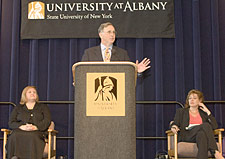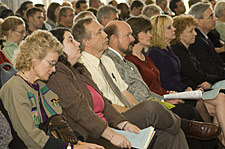Campus Update
by Greta Petry (October 6, 2006)
Portch Outlines BOV Vision for UAlbany
Stephen R. Portch, chair of the University at Albany's Board of Visitors and chairman emeritus of the University System of Georgia, said he's "never seen the UAlbany campus looking better." Portch said he sensed the University's "tremendous energy" as he arrived on Wednesday, Oct. 4, to address the Fall Faculty Meeting in the Campus Center Ballroom.
Portch and the Board of Visitors were brought in by the late President Kermit L. Hall, Provost Susan Herbst and the Executive Committee this past spring to assess the University's future from a national perspective. View the complete report >> (PDF file, requires Adobe Acrobat Reader)
 |
|
Stephen R. Portch, chair of the Board of Visitors, addressed the Fall Faculty Meeting Oct. 4 in the Campus Center Ballroom, saying the University at Albany needs to be "intensely focused" on the future. Seated, at left, are Diane Dewar, chair of the University Senate, and, at right, Provost Susan Herbst, who introduced Portch. (Photo by Mark Schmidt.) |
|
"You have weathered pretty tough conditions extremely well," Portch said, after being introduced by Provost Susan Herbst. In spite of budget cuts and a sometimes bureaucratic system, the University has forged ahead in nanotechnology and continues to build strength in policy areas.
"Our board felt this place is a lot better than it sometimes thinks it is," he said.
The Board of Visitors report notes the real strength in the University's compact planning process is "the new faculty positions to be added over five years – that is where the ‘bang for the buck" will come from." Indeed, Portch said, "Ultimately, the greatness of this University will depend on the quality of the faculty it brings in."
Portch gave the example of the University of Illinois, which is "three hours between cornfields," and yet has produced two Nobel Prize winners because it has "stockpiled faculty talent."
Continuing to add faculty lines in difficult financial times is critical to long-term academic strength. Encouraging interdisciplinary connections in compact planning proposals is also a factor, Portch said. The BOV report suggests that even greater interdisciplinary collaboration can be achieved in compact planning. "Towards that end, this value must be stated clearly up front, and potentially even made a criterion that, if met, will increase the likelihood of funding," the report said.
Portch noted there is "great potential" for interdisciplinary collaboration in the "high-profile" but "somewhat controversial" field of nanoscience, which "is clearly something that is part of a University signature."
In assessing the compact planning proposals, Portch said he sensed a bit of "constrained ambition," and believed some of them to be overly modest in scope.
He said there are possibilities for greater ambition and optimism.
While he cautioned against a simplistic goal, like wanting to be "in the top 20 research universities," he echoed the report's finding that it is important to articulate the University's ambition. "What should the University at Albany achieve in five years were it to stretch and optimize its human, financial, and other resources?" the report said.
 |
||
Faculty and staff listen as Portch says that stockpiling faculty talent girds long-term academic strength. (Photo by Mark Schmidt.) |
||
And while compact and strategic planning are important, overly rigid planning can lead to lost opportunities, he said. Toward that end, the BOV's report advises greater flexibility in budgeting. "The University also needs to be much more nimble to capture emerging opportunities. Though UAlbany has done a good job in the past, it has got to be even more agile in today's environment."
Portch speculated on the future impact of the political system on SUNY. The BOV report noted, "The fact that SUNY has a new Chancellor and that there will be a new governor provides an important opportunity to reconsider old ways of functioning and the (University) Council should position itself to influence the direction. Presently, we believe, New York is on the wrong side of the curve to manage the future of public higher education given all the constraints in place. Other public higher education institutions are gaining far more freedom. This is a good time to work with SUNY on giving the University more latitude to achieve its ambitions."
Finally, while Portch noted President Hall's untimely death was a great loss to the University at Albany, he said continuity on a college campus does not rely on longtime leadership by one person. The average president now serves five- or six-and-a-half years.
Stability lies with the faculty. "It is incumbent on us with long- term relationships (to the institution) to take on extra responsibility as not only keepers of the flame of tradition, but of the flame of the future."
He added, "There is going to be transition – that's a certainty. It is important to intensely focus on the future." Moving forward despite the "noise," is the key. "I think you've got to stay the course," he concluded.
